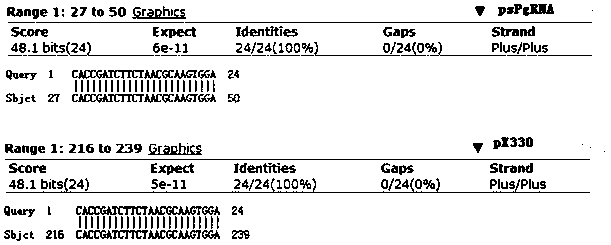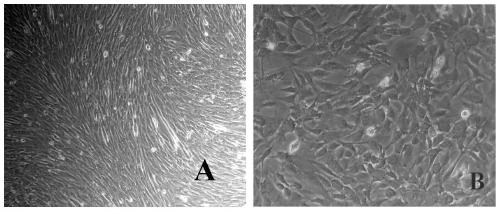Cell clone with MyoG (myogenin) gene knock-in and MSTN (myostatin) gene knock-out prepared by Crispr/Cas9 technique
A gene knockout and gene knock-in technology, applied in the field of genetic engineering, can solve problems such as affecting the number of muscle fibers and affecting the quality of meat
- Summary
- Abstract
- Description
- Claims
- Application Information
AI Technical Summary
Problems solved by technology
Method used
Image
Examples
Embodiment 1
[0020] 1. Experimental plan
[0021] 1) Construction of MSTN targeting vector
[0022] (1) Design and annealing of target site primers: According to the predicted target site site ( http: / / zifit.partners.org / ZiFiT / CSquare 9Nuclease.aspx) to predict the target site of the mature protein coding region of MSTN gene, and design corresponding primers for the second exon and third exon of MSTN according to the prediction results (see Table 1 for specific primers). The corresponding primers were diluted to a final concentration of 50nM, reacted at 94°C for 3min, incubated at 37°C for 1h, and annealed.
[0023] Table 1 The corresponding sgRNA primers designed according to the predicted target
[0024]
[0025] (2) Single enzyme digestion of psPgRNA and pX330 plasmids and recovery of carrier fragments: extract psPgRNA and pX330 using a plasmid extraction kit, absorb 1 ng each after measuring the concentration with a UV spectrophotometer, and perform single enzyme digestion wi...
PUM
 Login to View More
Login to View More Abstract
Description
Claims
Application Information
 Login to View More
Login to View More - R&D
- Intellectual Property
- Life Sciences
- Materials
- Tech Scout
- Unparalleled Data Quality
- Higher Quality Content
- 60% Fewer Hallucinations
Browse by: Latest US Patents, China's latest patents, Technical Efficacy Thesaurus, Application Domain, Technology Topic, Popular Technical Reports.
© 2025 PatSnap. All rights reserved.Legal|Privacy policy|Modern Slavery Act Transparency Statement|Sitemap|About US| Contact US: help@patsnap.com



